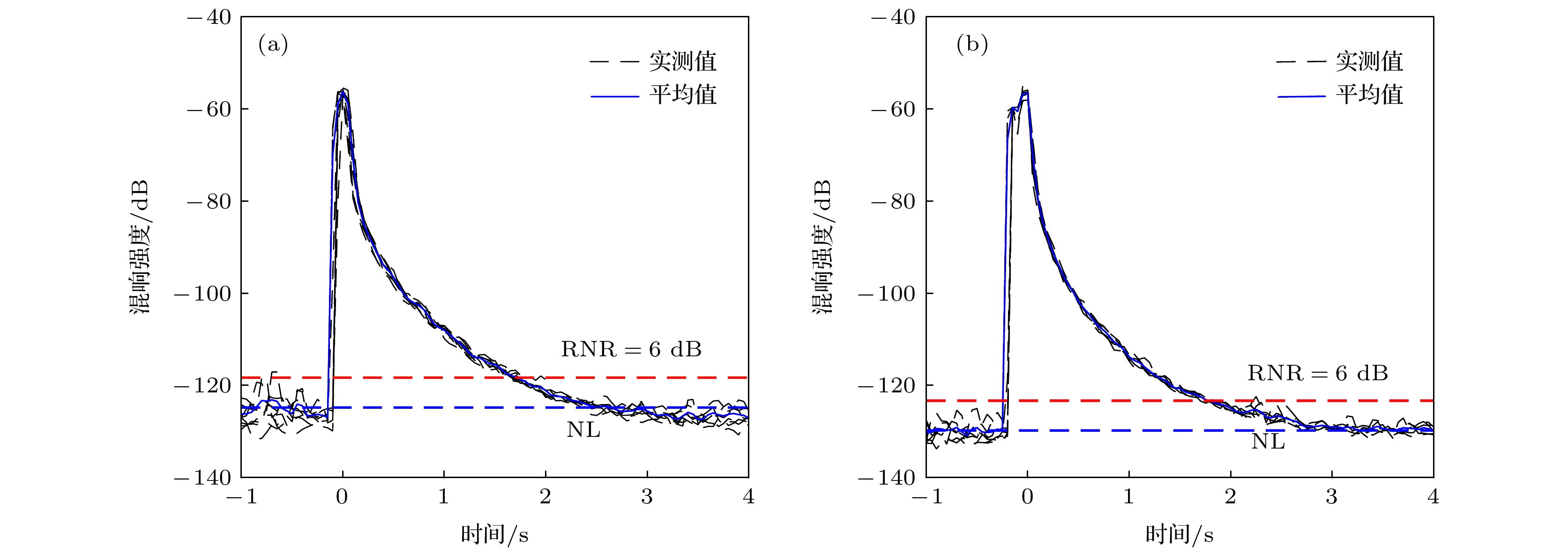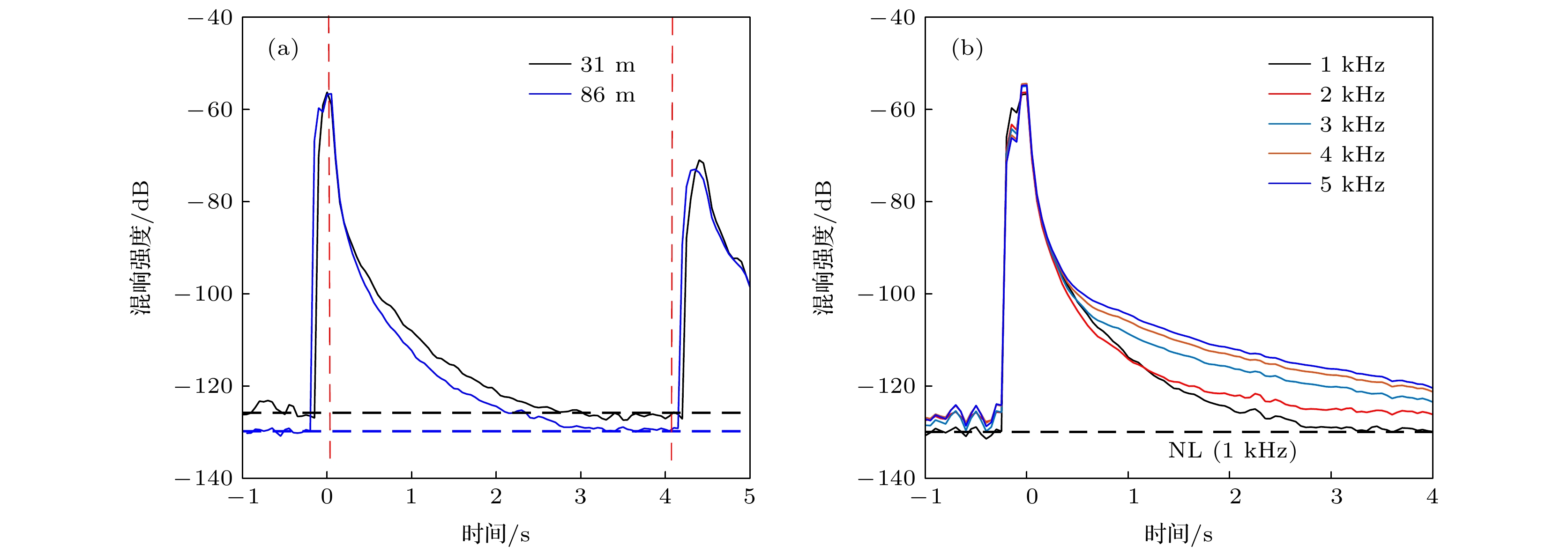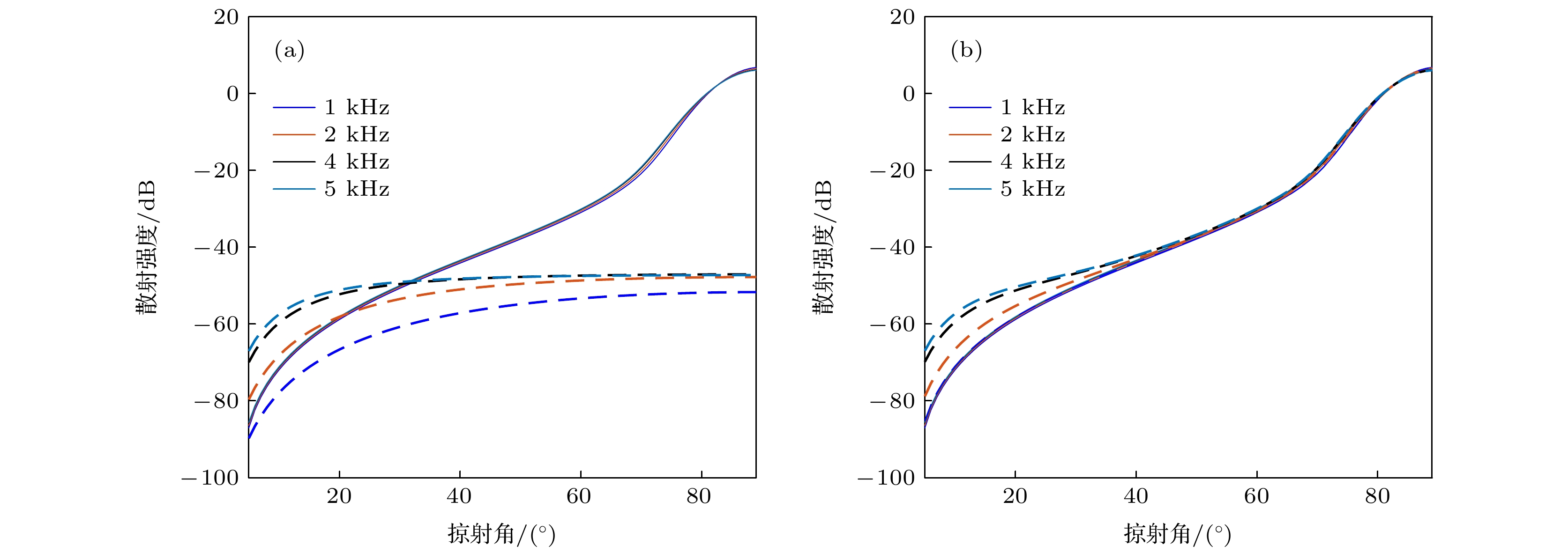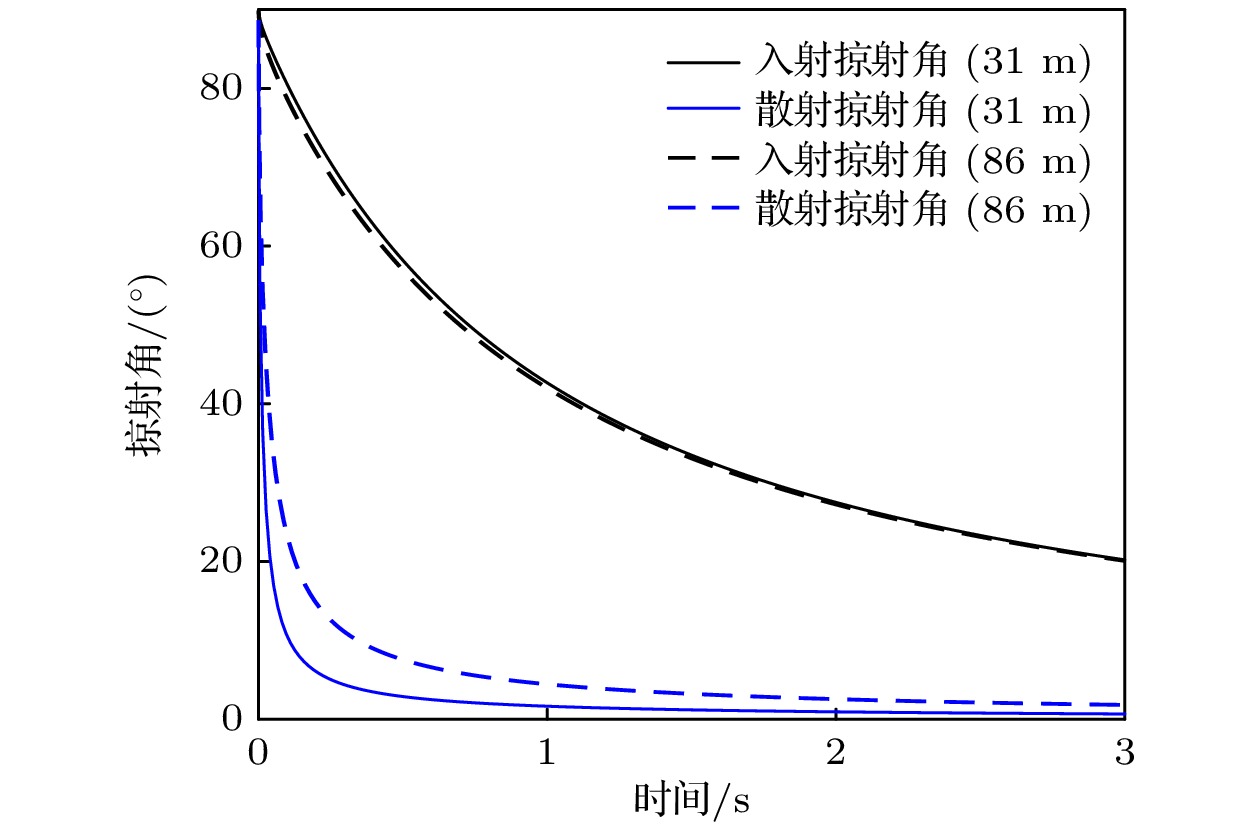-
收发设备在海面附近的深海混响实验中, 多途时延使得最先到达水听器的为海面混响信号, 且不受海底散射声场的干扰. 本文利用射线理论描述深海声传播的格林函数, 采用粗糙界面一阶小斜率近似方法描述全角度海面散射, 给出海面混响声场的表达式. 同时考虑了海面表层气泡散射的贡献, 获得了海面混响理论. 通过数值仿真数据和深海实验数据的比较对海面混响模型进行验证, 分析了不同接收深度、频率下的海面混响强度衰减趋势. 结果表明: 低海况条件下, 低频海面混响由粗糙界面散射主导, 气泡散射可以忽略, 随频率升高, 气泡散射对海面混响的贡献逐渐增大, 海面附近收发深度的小幅变化对混响衰减曲线的影响不明显. 基于该模型提出一种反演海面粗糙界面谱参数的方法, 数值计算结果验证了该模型能够在风速已知的前提下, 通过海面混响数据提取海面粗糙界面谱参数.For the reverberation experiments with a near surface source or receiver, surface reverberation arriving first after source signal is not influenced by bottom reverberation due to time-delay difference of acoustic multipath in deep water. A surface reverberation model is proposed in the paper. The Green’s function of sound propagation is described by the ray theory, and first-order small-slope approximation is employed for the surface scattering from full angle. The effect of bubbles scattering is also considered to get the surface reverberation theory. The reverberation model is verified by comparing the simulation results with the experimental data. The measured data show that the decaying rate of surface reverberation intensity decreases with the frequency increasing. Numerical calculation demonstrates that the frequency dependence is caused by the positive correlation between scattering strength and frequency, and the surface reverberation at low frequency for low sea state is dominated by the scattering from rough air-sea interface. Moreover, the reverberation data from experiment show that the surface reverberation is not sensitive to the change of receiving depth. A method of inversion for the two surface-wave spectral parameters in the model is achieved based on the reverberation model. The inversion results verify that the spectral parameters of rough surface can be obtained from surface reverberation data on the premise of the wind speed parameter. As a result, the scattering properties of rough interface will be obtained.
-
Keywords:
- deep-water reverberation /
- small-slope approximation /
- ray /
- scattering at surface roughness
[1] Bergmann P G, Spitzer L 1946 Summary Tech. Rep. 8 6
[2] Chapman R P, Harris J H 1962 J. Acoust. Soc. Am. 34 1592
 Google Scholar
Google Scholar
[3] Bachmann W 1973 J. Acoust. Soc. Am. 54 712
 Google Scholar
Google Scholar
[4] Crowther P A 1980 Collection in Cavitation and Inhomogeneities is Underwater Acoustics (Berlin: Springer-Verlag) p194
[5] Niitzel B, Herwig H, Monti J M, Koenigs P D 1987 The Influence of Surface Roughness and Bubbles on Sea Surface Acoustic Backscattering (New London: NUSC Tech. Rep. 7955, Naval Underwater Systems Center) pp1−61
[6] McDaniel S T 1988 Collection in Sea Surface Sound (Dordrecht: Springer) p225
[7] McDaniel S T 1993 J. Acoust. Soc. Am. 94 1551
 Google Scholar
Google Scholar
[8] McDaniel S T 1993 J. Acoust. Soc. Am. 94 1905
 Google Scholar
Google Scholar
[9] Richter R M 1964 J. Acoust. Soc. Am. 36 864
 Google Scholar
Google Scholar
[10] Ogden P M, Erskine F T 1994 J. Acoust. Soc. Am. 96 2908
 Google Scholar
Google Scholar
[11] Ogden P M, Erskine F T 1994 J. Acoust. Soc. Am. 95 746
 Google Scholar
Google Scholar
[12] Schneider H G 1993 J. Acoust. Soc. Am. 93 770
 Google Scholar
Google Scholar
[13] Ellis D D 1995 J. Acoust. Soc. Am. 97 2804
 Google Scholar
Google Scholar
[14] Bass F G, Fuks I M 1978 Wave Scattering from Statistically Rough Surfaces (New York: Pergamon Press) p103
[15] Voronovich A G 1986 Progress in Underwater Acoustics Plenum, Halifax, Nova Scotia, Canada, July 16−18, 1986 p25
[16] Dashen R, Henyey F S, Wurmser D 1990 J. Acoust. Soc. Am. 88 310
 Google Scholar
Google Scholar
[17] Maue A W 1949 Z. Phys. 126 601
 Google Scholar
Google Scholar
[18] Kampen N G 1981 Stochastic Processes in Physics and Chemistry (Amsterdam: North Holland) p66
[19] Gauss R G, Gragg R F, Wurmser D, Fialkowski J M 2002 Nasa Sti/recon Technical Report 8
[20] Jackson D R, Winebrenner D P, Ishimaru A 1986 J. Acoust. Soc. Am. 79 1410
 Google Scholar
Google Scholar
[21] Gauss R C, Fialkowski J M 2000 Proceedings of the Fifth European Conference on Underwater Acoustics, Lyon, France, July 10−13, 2000 1165
-
-
[1] Bergmann P G, Spitzer L 1946 Summary Tech. Rep. 8 6
[2] Chapman R P, Harris J H 1962 J. Acoust. Soc. Am. 34 1592
 Google Scholar
Google Scholar
[3] Bachmann W 1973 J. Acoust. Soc. Am. 54 712
 Google Scholar
Google Scholar
[4] Crowther P A 1980 Collection in Cavitation and Inhomogeneities is Underwater Acoustics (Berlin: Springer-Verlag) p194
[5] Niitzel B, Herwig H, Monti J M, Koenigs P D 1987 The Influence of Surface Roughness and Bubbles on Sea Surface Acoustic Backscattering (New London: NUSC Tech. Rep. 7955, Naval Underwater Systems Center) pp1−61
[6] McDaniel S T 1988 Collection in Sea Surface Sound (Dordrecht: Springer) p225
[7] McDaniel S T 1993 J. Acoust. Soc. Am. 94 1551
 Google Scholar
Google Scholar
[8] McDaniel S T 1993 J. Acoust. Soc. Am. 94 1905
 Google Scholar
Google Scholar
[9] Richter R M 1964 J. Acoust. Soc. Am. 36 864
 Google Scholar
Google Scholar
[10] Ogden P M, Erskine F T 1994 J. Acoust. Soc. Am. 96 2908
 Google Scholar
Google Scholar
[11] Ogden P M, Erskine F T 1994 J. Acoust. Soc. Am. 95 746
 Google Scholar
Google Scholar
[12] Schneider H G 1993 J. Acoust. Soc. Am. 93 770
 Google Scholar
Google Scholar
[13] Ellis D D 1995 J. Acoust. Soc. Am. 97 2804
 Google Scholar
Google Scholar
[14] Bass F G, Fuks I M 1978 Wave Scattering from Statistically Rough Surfaces (New York: Pergamon Press) p103
[15] Voronovich A G 1986 Progress in Underwater Acoustics Plenum, Halifax, Nova Scotia, Canada, July 16−18, 1986 p25
[16] Dashen R, Henyey F S, Wurmser D 1990 J. Acoust. Soc. Am. 88 310
 Google Scholar
Google Scholar
[17] Maue A W 1949 Z. Phys. 126 601
 Google Scholar
Google Scholar
[18] Kampen N G 1981 Stochastic Processes in Physics and Chemistry (Amsterdam: North Holland) p66
[19] Gauss R G, Gragg R F, Wurmser D, Fialkowski J M 2002 Nasa Sti/recon Technical Report 8
[20] Jackson D R, Winebrenner D P, Ishimaru A 1986 J. Acoust. Soc. Am. 79 1410
 Google Scholar
Google Scholar
[21] Gauss R C, Fialkowski J M 2000 Proceedings of the Fifth European Conference on Underwater Acoustics, Lyon, France, July 10−13, 2000 1165
计量
- 文章访问数: 6296
- PDF下载量: 98
- 被引次数: 0














 下载:
下载:









